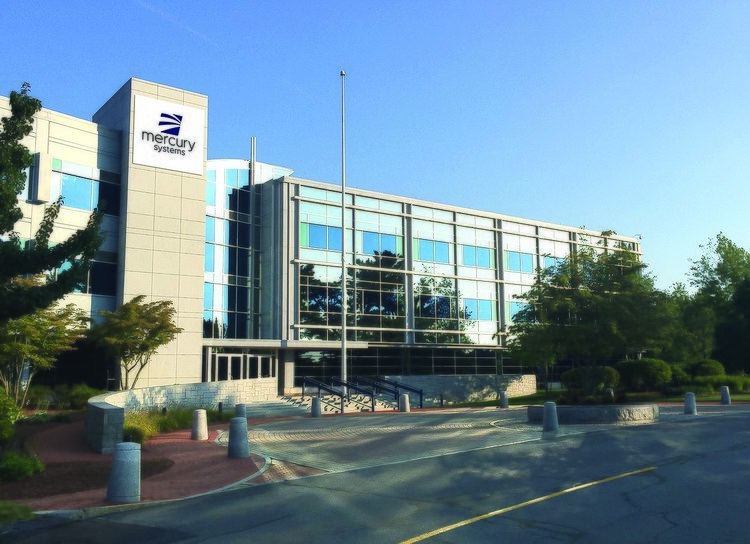Industry Aerospace and defense | ||
 | ||
Traded as NYSE: MRCYS&P 600 Component Founded Chelmsford, Massachusetts, United States (1981) Key people Mark Aslett(President/CEO) | ||
Mercury Systems, Inc.( NASDAQ: MRCY ) is a leading commercial provider of secure and safety-critical processing subsystems for defense applications. Headquartered in Andover, Massachusetts, Mercury is pioneering a next-generation defense electronics business model specifically designed to meet the industry’s current and emerging technology needs. Mercury has supplied processing subsystems to over 30 prime contractors, in over 300 programs. Their processing subsystems are used in Intelligence, Surveillance and Reconnaissance (ISR), Radar, Electronic Warfare (EW), storage and guidance defense applications.
Contents
History
Mercury's Next Generation Business Model
To meet Department of Defense (DOD) defense electronics procurement reform objectives, Mercury created a Next Generation Business Model. Defense procurement reform objectives are captured by the Department’s Better Buying Power 3.0 (BBP3.0) under the overarching theme of “Achieving Dominant Capabilities through Technical Excellence and Innovation.”
BBP3.0 highlights the need to leverage commercial technology through open system architectures thereby meeting agility, performance, interoperability and affordability objectives. Augmenting the requirements of BBP3.0 is the need to build security in to all defense processing systems to counter emerging threats, cyberattacks and reverse engineering. Mercury’s next-generation defense electronics business model meets BBP3.0 and counter contemporary security objectives by:
• Quickly adopting the best commercial technology in support of defense programs and missions
• Investing in R&D to complement the Pentagon’s, prime-contractors’, defense and non-profit labs’ own initiatives
• Creating secure processing subsystem building-blocks for pre-integrating into defense programs
Open System Architecture (OSA) for Digital and RF/Microwave Processing
Mercury has a systematic approach to the creation of defense processing subsystems using a sensor processing chain methodology to define reusable building blocks. This business approach leverages best commercial technology making Mercury processing building blocks interoperable and standardized, so defense processing subsystems are quickly developed.
Open system architectures (OSA) are fundamental to meeting the DOD’s BBP 3.0 objectives and are aligned with Mercury’s business posture. The company pioneered many of today’s embedded protocols and processing standards including RapidIO and OpenVPX (ANSI/VITA 65 standard) which is the de facto embedded digital processing standard.
Currently, the company is investing in OpenRFM for Radio Frequency (RF) and microwave processing that will bring interoperability to the RF/microwave domain, as OpenVPX did in the digital realm. OpenRFM standardizes the profiles, interfaces and protocols for RF and microwave processing enabling sensor chain applications to be fully open systems compliant. Mercury applies open systems architectures to software as well as hardware. This approach, applied to middleware preserves the software and application investments while adding new capabilities through tech-refreshes.
Built-in Security for Sensor Processing
Mercury's third generation security framework is built-in to all their processing building blocks for system-wide security that is personalized and private for each application. This agnostic built-in security foundation spans 3U and 6U OpenVPX, secure-AdvancedTCA and rackmount ATX architectures enabling processing solutions to span platforms and form-factors.
Built-in Safety for Mission Computing
Mercury’s acquisition of CES brought Design Assurance Level (DAL) capabilities to the company’s portfolio, for both DO-254 (software) and DO-178 (hardware). These capabilities are required for safety-critical mission computing used in commercial and military, manned and unmanned platforms.
The integration of CES’s flight safety capabilities and Mercury’s secure sensor processing capabilities is enabling the connection of the effects grid to the sensor grid through affordable open systems architectures.
Major innovations
Corporate Headquarters
Mercury is headquartered in Andover, Massachusetts within a secure and Defense Microelectronics Activity (DMEA) certified state-of-the-art facility. The facility incorporates a world-class design and engineering capability and an Innovation Center. Mercury Innovation Centers showcase the company’s sensor and mission processing solutions.
Manufacturing Centers
Mercury has redundant, scalable Advanced Microelectronic Centers (AMCs). AMCs are dedicated to the production of defense industry subsystems within a world-class, domestic manufacturing environment. AMCs are operated in New England, New York Metro-area, Southern California and a trusted DMEA facility in the Southwest, which also has Missile Defense Agency approval and AS9100 certification.
Company structure
Mercury has three major product lines:
• Advanced Microelectronic Solutions / RF & Digital Solutions
• Sensor and Mission Processing - Mercury Mission Systems; Safety-critical avionics, mission processing, networking, and communication; Secure high-performance sensor processing, storage, and networking
• Mercury Defense Systems – Electronic Warfare; Secure Processing Solutions; Test & Simulation
Mercury’s businesses are supported by several dedicated international operations including: Silchester, United Kingdom, Tokyo, Japan and Geneva, Switzerland.
